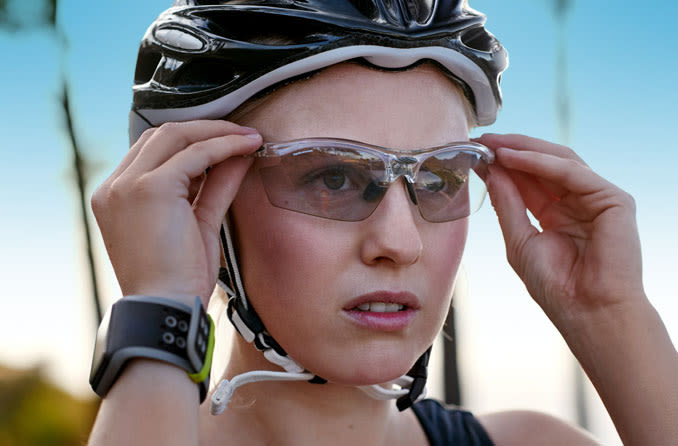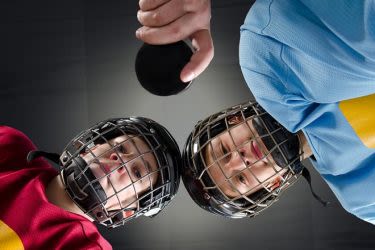How to choose protective sport glasses and goggles

Not long ago, athletes rarely wore eyewear specifically designed to protect their eyes during sports, and sports-related eye injuries were widespread.
Today, sports eyewear can be spotted on almost anyone who picks up a ball, bat, racket or stick — whether they play professionally or in amateur tournaments.
Fortunately, coaches, parents and players now realise that wearing protective eyewear for sports pays off in several ways. The risk of eye damage is reduced, and the player's performance is enhanced by the ability to see better. In fact, many athletic and fitness clubs today do not permit their members to participate without wearing proper eye gear.
In the past, there was some resistance by children to wear protective sports eyewear because they thought it might make them “look funny.”
Today — thanks to sports eyewear being routinely worn by professional athletes — protective goggles, face shields and other sports eyewear are widely accepted, much the way bike helmets have become the norm. In addition, both children and adults like the image that wearing modern sports eyewear gives them: It shows they mean business on the playing field.
If you're not wearing eye protection for sports, consider this...
Any sport in which balls, rackets or flying objects are present pose a potential for eye injury.
In squash, for example, the ball can travel up to 140 miles per hour (62.6 metres per second) or even faster. The same is true for tennis.
In cricket, the fastest bowlers can deliver the ball at 93 miles/hour (41.6 metres/sec) or faster.
Even sports such as badminton can cause significant eye injuries. (You may be surprised to learn that the fasted shuttlecock speed recorded was approximately 306 miles/hour, or 136.8 metres/sec!)
Another potential danger is that the rackets and bats themselves move at high speed in a confined space and could strike a player.
Flying objects aren't the only hazard. Many eye injuries come from pokes and jabs by fingers and elbows, particularly in games where players are in close contact with each other. Rugby, for example, has an extremely high rate of eye injury.
Features to look for in protective sports eyewear
Prescription spectacles, sunglasses, and even on-the-job industrial safety glasses typically do not provide adequate protection for sports use.
Sports goggles are made in a variety of shapes and sizes. Many are designed for racket sports and are available for basketball and football. Some are even designed to fit in helmets used for Hockey and cricket.
Lenses in sports eyewear usually are made of polycarbonate. Since polycarbonate is such an impact-resistant lens material, it works well to protect eyes from fast-moving objects. Polycarbonate also is lightweight and has built-in ultraviolet protection — a valuable feature for outdoor sports.
The eyewear frame also plays an important role in the safety, comfort and visibility of sports eyewear. Also, different sports require different types of frames, which has led to development of sport-specific frames.
Most sport frames can accommodate both prescription and nonprescription lenses. Sport frames are constructed of highly impact-resistant plastic or polycarbonate, and many feature rubber or silicone padding to cushion the frame where it comes in contact with the head and nose.
Some sports styles are contoured, wrapping slightly around the face. This type of goggle works well for biking, hang-gliding and sailing. Contact lens wearers especially benefit from a wraparound style, as it helps keep out wind and dust.
SEE RELATED: Sport sunglasses: Controlling light, enhancing performance
Important fitting considerations for children
Sport goggles and other sports eyewear must be properly fit to the individual wearer. This is particularly important with children, because the normal temptation is to purchase a larger goggle than is needed today so the youngster has "room to grow."

Never let your child play hockey without wearing a face mask. Hockey pucks are very dense and hard, and when one hits an eye at high speed, it can cause vision loss and even total blindness.
Some growing room is acceptable, and sports goggles are made to be somewhat flexible in their width adjustment.
But if the frames are too large and don't fit properly, the amount of protection they provide will be compromised, increasing the risk of eye injury. It's a risk not worth taking.
By the same token, permitting a youngster to continue wearing goggles that he or she has outgrown can be just as dangerous.
First, the frames will be uncomfortable, tempting the child to take them off. Second, the frames can obstruct peripheral vision, leading to poor performance and a greater risk of being hit by a ball or other unseen object from one side or the other.
Review the fit of your child's sport goggles each year to ensure that they are still providing proper protection. Make sure the padding inside the sides of the goggle rests flush with the face and the eyes are centred both horizontally and vertically in the lens area.
FIND AN OPTICIAN OR OPTICAL SHOP NEAR YOU: Our locator lists nearby opticians and optical shops to make booking appointments easy.
Page published on Wednesday, 26 June 2019






